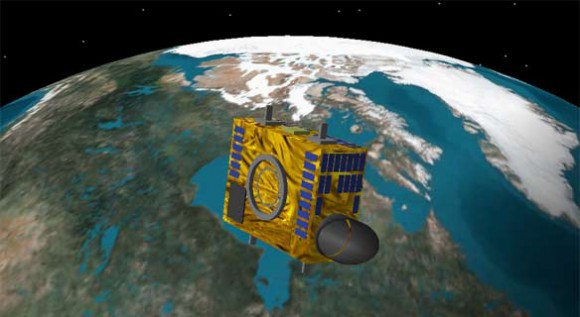Click to play embedded YouTube video.
http://www.universetoday.com/100187/satellite-swarm-readies-for-spaceflight/#more-100187 wrote:
Satellite Swarm — Including an Asteroid Hunter — Readies For Spaceflight
by Elizabeth Howell on February 23, 2013
<<Early next week, an Indian rocket will launch into space carrying seven satellites on board. Among them will be a small but mighty asteroid-hunting telescope called NEOSSat. Built by the Canadian Space Agency, it will mainly focus on the Atira class of asteroids, which are made up of space rocks within Earth’s orbit, to figure out their size and distribution. The suitcase-sized NEOSSat will orbit approximately 800 kilometers above Earth, searching for near-Earth asteroids that are difficult to spot using ground-based telescopes.
NEOSSat [Near-Earth Object Surveillance Satellite], the satellite is actually split into two different missions. For half the time, it will be keeping a sharp eye out for asteroids that may swing by Earth at some point. The telescope will spend its other science mission watching satellites and space debris in orbit, to better track their movements.
“NEOSSat will discover many asteroids much faster than can be done from the ground alone,” said Alan Hildebrand of the University of Calgary. “Its most exciting result, however, will probably be discovering new targets for exploration by both manned and unmanned space missions.”>>
http://en.wikipedia.org/wiki/Near_Earth_Object_Surveillance_Satellite wrote:
<<The Near Earth Object Surveillance Satellite (NEOSSat)[ is a Canadian microsatellite using a 15-cm aperture f/5.88 Maksutov telescope similar to that on the MOST spacecraft, 3-axis stabilized with pointing stability of ~2 arcseconds in a ~100 second exposure. It will search for interior-to-Earth-orbit (IEO) asteroids including those sometimes called Apohele asteroids at between 45 and 55 degree solar elongation and +40 to -40 degrees ecliptic latitude. NEOSSat will be launched by PSLV-C20 on February 25, 2013.>>
http://en.wikipedia.org/wiki/Apohele_asteroid wrote:
<<Apohele asteroids, or alternatively Interior-Earth Objects (IEOs) or Atira asteroids, are a subclass of Aten asteroids. They have not only their perihelion within Earth's orbit, but also their aphelion; that is, their entire orbit is within Earth's (which has a perihelion of 0.983 AU).
The first suspected Apohele was 1998 DK36, the first confirmed Apohele was (163693) Atira in 2003. As of March 2010, there are 10 suspected Apoheles, of which seven have been observed in multiple oppositions, and the orbits of two have been determined with sufficient precision to receive a permanent number; 28 more objects have aphelia shorter than the Earth's aphelion (1.017 AU). The Near Earth Object Surveillance Satellite is intended to find more.
In great part because of the search methods used to look for asteroids, there are currently no known asteroids with orbits contained within Venus or Mercury's (e.g. vulcanoids).
There is no standard name for the class. The name Apohele was proposed by the discoverers of 1998 DK36, and is the Hawaiian word for orbit; it was chosen partially because of its similarity to the words aphelion (apoapsis) and helios. Other authors adopted the designation Inner Earth Objects (IEOs). Still others, following the general practice to name a new class of asteroids for the first recognized member of that class, use the designation Atira asteroids.>>
